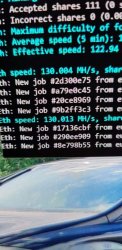Zacksa
Tukijäsen
- Liittynyt
- 30.10.2016
- Viestejä
- 3 936
Tekeekö samaa jos laitat coren vaikka 1100?Missähän voi olla vika kun Asus RTX3070 EK:n (eli vesijäähdytetty) hashrate saattaa välillä tippua jopa 30MH/s, mutta palautuu jonkun ajan kuluttua kuitenkin sinne 60MH/s. Core clock on 1065 ja Mem 7970. Mitään virheitä ei näy minerissa. Core lämpö on <40C ja hotspot <60C.
Ja kun toi hashrate tippuu, niin myös virrankulutus tippuu n. 110W -> 80W. Voisiko syy olla kuitenkin muistien lämmöissä? (vaihdoin uudet lämpötyynyt kun sain tämän kortin)



